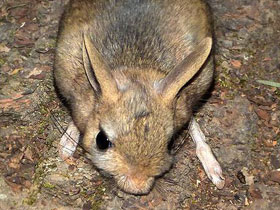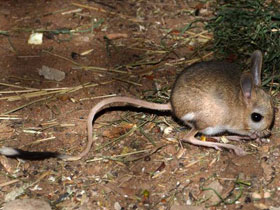The small five-toed jerboa (Scarturus elater)
The small five-toed jerboa (Scarturus elater) is a rodent of the family Dipodidae and genus Scarturus, that has five digits.
Appearance
The body length of Scarturus elater ranges from 5 to 10 cm, tail length from 20 to 25 cm, and weight from 44 to 73 g. Its tail is long, its eyes and hind limbs are large. The back is dark to dull grey in colour. The flanks are light, dusky yellow. Neck, breast, belly snow-white. It has long vibrissae. The paws have five toes.
Habitat
Scarturus elater is distributed in the following countries: Afghanistan, Armenia, Azerbaijan, China, Georgia, Iran, Kazakhstan, Kyrgyzstan, Mongolia, Pakistan, Russian Federation, Tajikistan, Turkey, Turkmenistan, Uzbekistan. It inhabits desert and semi-desert regions and avoids open spaces and dense vegetation. This species is found in some degraded habitats and along the margins of agricultural areas.
Lifestyle and habits, food, reproduction
Scarturus elater moves at speeds of up to 48 kilometres per hour. It feeds on various grasses, seeds and insects. It is secretive, active at dusk and at night. It lives in burrows up to 2 m long and 70 cm deep. In most of its range Scarturus elater spends about four months in hibernation (from mid-November to mid-March), but in Transcaucasia it does not hibernate. The reproductive period begins after winter hibernation (in Transcaucasia in February). There are two reproductive peaks in April and in August-September. Scarturus elater may have up to three broods per year, each with 2 to 6 cubs.
Distinctive features
Scarturus elater is the smallest of the ground hare genus, weighing six to seven times less than the larger forms. The fur of the back is grey-pale, on the sides the fur is lighter, pinkish, the throat, breast and abdomen are snow-white. Body length of Scarturus elater 95-137 mm (usually up to 115 mm), hind foot 48-56 mm, skull 25-27 mm (rarely up to 29.7 mm), tail length up to 205 mm (usually 1500-180 mm), ear height 34-42 mm, condylobasal length of skull 25-27 mm, zygomatic width 192-217 mm, maxillary row of teeth 48-41 mm. Externally Scarturus elater is very similar to the greater gopher, differing, apart from the almost twice smaller size, by a slightly more elongated head, and also by details of the structure of the male sexual organ.
External features
The muzzle is slightly elongated, somewhat flattened in front, the ears are long, the hind limbs are five-toed, the main part of the "banner" is black, divided below by a longitudinal white stripe, the terminal part is white. In front of the black part there is a clearly visible light-coloured field. The tail is long, up to 20 cm, serves as a balancer when jumping. The "banner" of the tail is black with a white tip. Nose in the form of a "nickel" - flattened in front.
Longitudinal furrow on dorsal surface of penis almost reaches apex and only just branched into 2 short lateral furrows; main part of it without spines. The colouration of Scarturus elater is from brownish-rusty to light sandy, the abdomen, limbs and the stripe running posteriorly on the femur are white.
In the Pleistocene, reliable finds of remains are known far to the west of the limits of the species' modern range - from Palaeolithic sites in the Crimea, and somewhat closer to the modern boundaries - from alluvium of the Lower Don (Tsimlyanskaya, Nagavskaya) and the lower reaches of the Urals (Mergenevskoe, Chapaevo). It is also known from Pleistocene asphalt of the Apsheron Peninsula.
Where Scarturus elater live
Allactaga elater is an inhabitant of semi-deserts of Armenia, Azerbaijan, plains of the Eastern Caucasus, southern Volga region, deserts of Kazakhstan, Central Asia, Iran, Afghanistan, China (Dzungaria). Here it inhabits flat areas of clay and rubbly deserts. It prefers areas with very sparse vegetation cover or settles on the margins of extensive takyrs, shores, solonchaks. Penetrates far into ridgy-hilly sands of Karakum along chains of shoras. Avoids continuous sandy massifs. Usually settles on areas unsuitable for farming. In river valleys of the desert zone settles on clay plots among willow and buckthorn bushes or dense thickets of chia (Lasiagrostis). In the mountains - up to 1100-1200 m above sea level. In the vicinity of Termez inhabits the most deplorable areas of clay steppe covered with scanty vegetation; in some places this animal settles even within the city limits on wastelands and some areas overgrown with camel thorn (Alhagficamelorum).
Like most desert species Scarturus elater is active at night and spends the day in a dug-out burrow. The little marmoset burrows both on smooth areas devoid of vegetation and under the protection of clumps of mugwort, saltbush cushions, under the bases of semi-shrub trunks. The animal often camouflages its entrance in the slopes of waterbodies and in road ruts. Closed by a short earthen plug, the entrance is hardly noticeable.
Dwelling structure, burrows
Usually digs two types of burrows: simple temporary and permanent - summer and winter burrows, much deeper and more complex. Burrows are simple, sloping, often with few blind nooks, the entrance is plugged with an earth plug for a day. The initial part of the passage in a dwelling burrow is always blocked with earth, but this plug never reaches a considerable length and usually the passage is opened after 2-3 blows with a spade. The length of the main passage is 1-1.5 m, the nesting chamber is located at a depth of about 60 cm. Spare outlets often end blindly below the soil surface and do not have holes closed with an earthen plug. The shape of the excavated pile is variable, but more often irregularly rounded. Scarturus elater often digs its dens in small depressions in the soil, road ruts, etc.; in these cases the dug earth fills these depressions and then finding the dens becomes even more difficult; often the dens are located under bushes of plants or among them. The nest chamber is situated at a depth of thirty to seventy centimetres and is lined with dried grass stalks, scales of ephemeral bulbs and other material. The nest is spherical, made of soft vegetable rags.
Kolesnikov (1934) distinguishes three types of burrows of this animal: the first type includes burrows with one or two corks (more often one) outside, one or three dead ends going to the surface and ending blindly (not reaching one or two centimetres to the surface), one gallery leading from the cork deep into the ground to the nesting spherical chamber. The second type of burrow has a single cork outside, from which there is a single passage deep into the ground, ending in a nesting chamber, also spherical in shape. The third type resembles in general features the second, but differs from the latter by the presence of special extensions located along the course of the gallery; the number of these extensions, called by the author additional chambers, varies from 1 to 3 in the burrow; these chambers have no nests and lie at different depths from the surface of the ground. The latter type of burrows serve, according to the author's observations, as winter burrows in which the animals spend their hibernation. He describes the way of burrow digging by the marmot in the following way: "when digging, it uses its front legs and teeth. As the heap of raked earth was growing, the little gopher raked it either with its hind legs, or pressed with its body against the loosened heap of earth and raked it further by moving forward. Working in this way and repeating the described movements several times, he gradually deepened the hole. About 30 minutes after the beginning of work, we saw that the gopher began to block the entrance. He did it in an original way: bringing a loose and small heap of earth to the exit, by frequent head movement, evenly distributing particles at the very edge of the entrance, the rodent gradually formed a plug. All this work, as noted, took 40 minutes."
If you start digging up a Scarturus elater burrow, the animal blows out the thin roof of the escape route and runs away for a long distance and then tries to take refuge in the first open burrow it finds, as well as in the burrow of a gerbil or other animal. The running of Scarturus elater is swift, but the speed is much slower than that of the larger gerbils. Like other five-toed Scarturus elater tends to run and play on roads, and in the morning its tracks, as well as body and tail prints, can always be found in large numbers in the road dust.
Breeding
The breeding period extends from April to June, with females bearing two to six cubs (five on average). The mating period is protracted, apparently occurring shortly after awakening. Young animals appearing on the surface at the end of May-June look very long-legged and heady. Indeed, their still small body rests on their hind legs, which have almost reached their "adult" length. The animals are not yet very confident on their feet, but in case of danger they are already able to make sharp jumps from side to side and run a considerable distance.
Scarturus elater is very fast travelling
The long-legged Scarturus elater is characterised by its fast running. Easily flying over dry streambeds, water holes or bushes of saltbush, the animal can run hundreds of metres before looking for an opportunity to hide in vegetation or in a burrow. Surprisingly, these highly terrestrial rodents are not deterred even by water obstacles. Once, a pursued Scarturus elater jumped into a wide ditch, swam across it, simultaneously pushing off with its hind legs as if on a run, and, having jumped out on the opposite bank, continued its rapid run as if nothing had happened. In the dark time of the day most of the encountered gerbils, getting into the strip of light, stopped on the spot and did not run away from the road even when the wheels of the car passed at a distance of not more than a metre from them. It seemed that in this case Scarturus elater did not run to the light, but being unexpectedly caught by a blinding light on the road, were stunned by it and were in complete confusion.
Seasonal behaviour
The period of active activity of these rodents lasts approximately 8 months - from the middle of March to the middle of November. Already at temperatures below -10°C the little gerbils fall into torpor. Scarturus elater feeds on tubers, bulbs, vegetative parts of plants and their seeds, and occasionally on insects. With pleasure digs up sown seeds of sunflower and melon crops, thus causing damage to agriculture. In most cases Scarturus elater lives in areas unsuitable for farming and is not a pest of agriculture.

















































